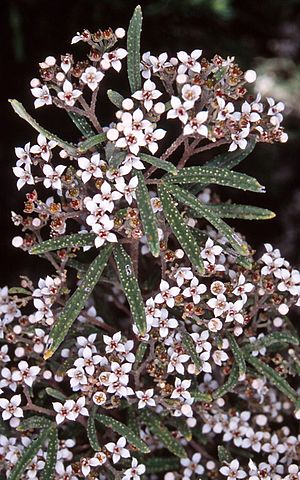Parris' zieria facts for kids
Quick facts for kids Parris' zieria |
|
|---|---|
 |
|
| Zieria parrisiae in the ANBG | |
| Conservation status | |
| Scientific classification | |
| Genus: |
Zieria
|
| Species: |
parrisiae
|
Zieria parrisiae, also known as Parris' zieria, is a special plant that belongs to the citrus family called Rutaceae. This plant is endemic, meaning it only grows naturally in a small area near Pambula on the south coast of New South Wales, Australia.
Imagine a bushy shrub with bumpy leaves that look a bit like clover! These leaves are made up of three smaller parts called leaflets. In spring, Parris' zieria gets clusters of up to 24 white or pale yellow flowers. These pretty flowers, each with four petals, grow near the ends of the branches.
Contents
What Does Parris' Zieria Look Like?
Parris' zieria can be a bushy shrub or even a small tree. It sometimes grows as tall as 9 meters (about 30 feet)! Its younger branches are bumpy, like they have tiny warts, and they are covered with soft, star-shaped hairs.
The leaves are made of three lance-shaped leaflets. Each leaf has a stem called a petiole, which can be 2 to 40 millimeters (about 0.08 to 1.6 inches) long. The middle leaflet is usually 25 to 35 millimeters (about 1 to 1.4 inches) long and 3 to 4 millimeters (about 0.1 to 0.16 inches) wide. The top side of the leaflets is dark green and bumpy, and it's mostly smooth (called glabrous). The bottom side is lighter green and covered with soft, velvety, star-shaped hairs.
Clusters of 9 to 25 white or pale yellow flowers grow where the leaves meet the stem (these spots are called leaf axils). These flower clusters are about the same length as the leaves. Small leaf-like structures called bracts surround the clusters and stay there even when the flowers are blooming.
Each flower has four triangle-shaped sepal lobes, which are tiny, only 1 to 2 millimeters (about 0.04 to 0.08 inches) long. It also has four spoon-shaped petals, about 2.5 millimeters (about 0.1 inch) long, covered with soft hairs. Inside each flower, there are four stamens, which are the parts that produce pollen.
Parris' zieria flowers in October and November. After flowering, in December and January, it produces fruit. The fruit is a bumpy, smooth, four-part capsule that holds the seeds.
How Did It Get Its Name?
The plant Zieria parrisiae was officially described for the first time in 2002. Two scientists, John D. Briggs and James Andrew Armstrong, gave it its formal name. They studied a plant sample (called a specimen) that was collected west of Pambula. Their description was then published in a science journal called Australian Systematic Botany.
Where Does It Live?
Parris' zieria grows in tall, open forests. You can find it in places like Wadbilliga National Park, the South East Forests National Park, and near Cochrane Dam. All these locations are in New South Wales, Australia.
Protecting Parris' Zieria
This special zieria plant is listed as "vulnerable." This means it's at risk of becoming endangered if its situation doesn't improve. It's listed as vulnerable under both the New South Wales Threatened Species Conservation Act and the Australian Commonwealth Government's Environment Protection and Biodiversity Conservation Act 1999 (EPBC) Act. The biggest reason it's vulnerable is that there are only small groups of these plants, making them more fragile and easily affected by changes in their environment.


